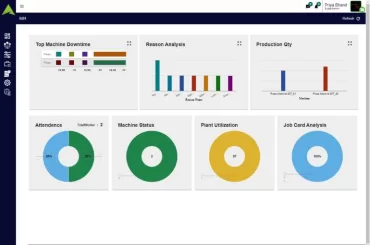Condition monitoring is the process of continuously checking on the health of an asset or system to find any early indications of deterioration or malfunction. It can assist in spotting potential issues before they become serious and lead to downtime or failure by routinely gathering and analyzing data on the condition of an asset.
Making the most of an asset’s capacity, lifespan, and availability, when needed, are all part of maximizing asset utilization.
Condition monitoring techniques are used on a variety of equipment, including rotating machinery, auxiliary systems, and parts such as compressors, pumps, motors, and presses.
Traditional condition monitoring was primarily based on vibration analysis, but more modern, inventive techniques use sensors to measure various parameters in real time and can send an alert when a change is detected.
Condition monitoring can be broken down into three main parts:
1. Installation of the monitoring system
Installing the hardware for the monitoring system onto your serviceable equipment is the first step in the condition monitoring process. This might necessitate some retrofitting or modification of your current assets, with various pieces of equipment necessitating various approaches or instrumentation.
2. Measurement of Baseline Data
After installing the monitoring system, you can start evaluating how well your equipment is working. The information gathered may consist of vibration, rotor speed, temperature, and data from process sensors. You will now have a baseline to compare your equipment’s current operating conditions to in the future.
3. Constant monitoring
The system can now keep an eye on your systems using sensors and condition monitoring software that assesses performance and offers diagnostics. When an operational abnormality is discovered, the system can also alert the user and analyse the information to decide whether immediate action is necessary or whether the machine can continue to function for a while longer while maintenance is planned.
In this article, we will cover the ways condition monitoring can help increase asset utilization:
Preventing downtime
By identifying potential issues early on, condition monitoring can reduce downtime by preventing equipment failure or unscheduled downtime. Condition monitoring systems continuously monitor an asset’s health, looking for any changes in performance or behavior that might point to a potential issue.
Maintenance teams can address these problems before they become serious by detecting them early. These systems can also spot trends in equipment performance and predict when an asset may fail by analyzing data over time. This can allow maintenance teams to intervene before a failure occurs, preventing downtime.
They can even help maintenance teams perform maintenance only when it’s necessary, based on the actual state of the asset.
Optimizing maintenance
Maintenance can be planned more effectively if it is based on the actual state of an asset rather than a predetermined schedule thanks to condition monitoring data. By doing so, you may be able to decrease pointless maintenance and improve asset utilization.
It can assist in extending the life of an asset by identifying potential problems before they develop into larger problems. As a result, less maintenance may be needed throughout the asset’s lifetime.
With condition monitoring, it becomes easier to identify the most efficient maintenance approaches for each asset by analyzing data over time, allowing maintenance teams to optimize their maintenance programs.
Extending asset lifespan
Condition monitoring systems continuously check on an asset’s health, looking for any alterations in performance or behaviour that might point to a potential issue. Early fault detection allows maintenance teams to address them before they become serious problems that could permanently harm the asset.
Over time, this may result in increased use.
Enhancing effectiveness
Condition monitoring can also spot opportunities for optimization, like cutting down on energy use or raising operational effectiveness. This can increase asset utilization while lowering costs.
Condition monitoring can increase asset efficiency by decreasing downtime, enabling predictive and condition-based maintenance, enhancing asset performance, and optimizing maintenance strategies. Organizations can lower costs, boost productivity, and strengthen their competitive advantage by increasing efficiency.
To Conclude
Connecting machines with the help of IoT can offer comparable data analysis of an entire production process regardless of whether the machines are carrying out similar tasks or not. As soon as a change in running levels is detected across the chain of production, operators in charge of the assets can assess where the problems may be and act upon imminent faults.
If you are interested in knowing how condition monitoring can improve asset utilization, feel free to talk to us and we will walk you through how our Asset Intelligence solution works and how it can help you achieve your business targets and reduce your carbon footprint considerably.
Inteliiot is a tech-enabled company that unleashes the power of IoT to help you improve your business using various services. By helping our customers create more goods and services while using fewer resources, we at Inteliiot are contributing towards building leaner and more responsible supply chains.





